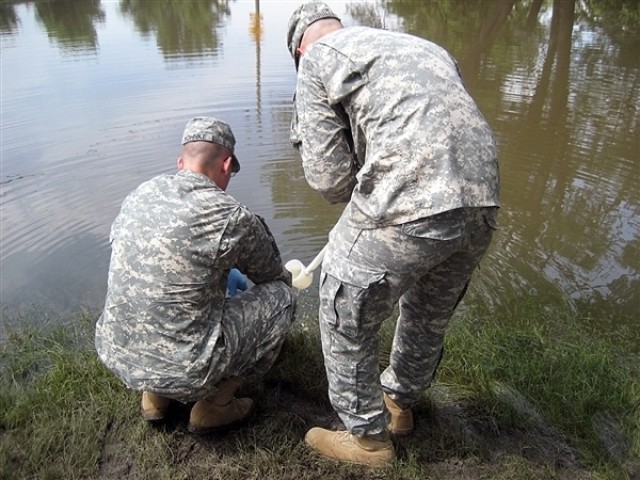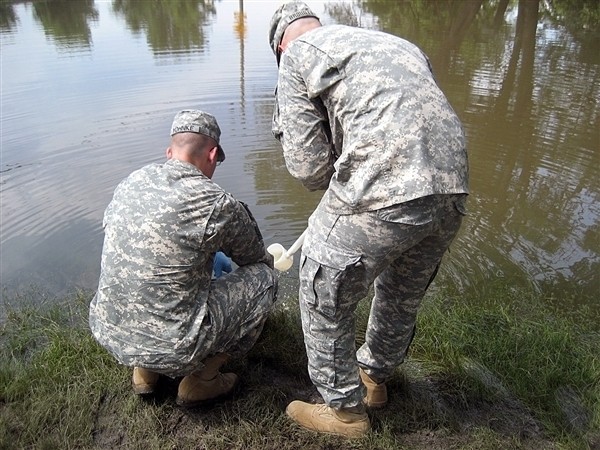
DES MOINES, Iowa (AFPS, July 1, 2008) - A National Guard counterterrorism unit has been wet and waist-deep in its battle against hazardous materials caught up in floodwaters in Des Moines, Iowa.
Tapping into their emergency support knowledge, the Iowa National Guard's 22 citizen-soldiers and -airmen of the 71st Weapons of Mass Destruction Civil Support Team have waded through the state's flood waters since June 16 to help officials assess chemicals and other potentially hazardous materials floating through their towns and cities.
Nearly 6,000 National Guard members have assisted civil authorities and responded to callouts by their governors in five states for the destructive and record-setting Midwest floods since early June.
The Iowa Guard's federally funded civil support team normally responds to events known or suspected to involve the use of chemical, biological or radiological agents. But the team members used their hazardous materials expertise, as well as their communication systems and their relationship with state and federal agencies, to identify and secure more than 130 hazardous substances dislodged by the flood in unmarked containers, gas cans, barrels and thousand-gallon chemical tanks.
"Customarily, we train and function in the counterterrorism role," Army Lt. Col. Timothy Glynn, CST commander, said.
But in Iowa, more than 45,000 people were displaced by at least 600 miles of rivers overflowing their banks. Glynn said the flood challenged his specialized response team to find a productive role to assist civil authorities, aside from its standard role in WMD events.
"We had to figure out what our place was," he said. "It's too easy to suddenly think, 'Let's go fill sandbags,' when you have a highly specialized group of trained individuals."
Oddly, protecting the public and the environment from dangerous substances crossed over from a terror response role to a natural disaster response role for the CST.
Fifty-eight Iowa counties came under federal disaster declaration. With thousands of unknown, dangerous substances literally floating away from garages and industrial sites, officials said, the state faced a major challenge locating and identifying its hazardous materials to protect the public.
The CST decided to help the state's department of natural resources set up a command center for their hazardous materials response, which provided data and voice communications. The team also established contacts with hazardous materials storage sites to see if they had any problems, on behalf of the state. They even sent out survey teams in trucks and boats to locate and identify hazardous items along rivers near Des Moines, Iowa City, Cedar Falls and Cedar Rapids.
Glynn said the team joined with conservation agents to recover more than 5,700 suspected containers. From them, they identified 58 hazardous materials containers found on land and 69 found in the water. They also found and identified 15 hazardous materials containers through aerial reconnaissance missions with the Civil Air Patrol.
"It worked well," Glynn said. He explained that a short disaster response period affected the amount of state and federal infrastructure and personnel in place for the floods. Some agencies, he explained, did not have full response teams available for two weeks, so the CST filled the gaps until civil authorities could take over.
Glynn said he would hand off the CST mission to Environmental Protection Agency officials next week.
"As the National Guard, we're ready to help and respond ... to plug a gap that exists with the civil authorities, and that's what we did," Glynn said. "As soon as they are able to ramp up, then we graciously back out."
The National Guard operates 55 weapons of mass destruction civil support teams, including one in each of the 54 states and territories, with two CSTs in California. The nation's first CST was certified and fully operational in August 2001. The Iowa Guard's 71st CST was certified and fully operational in January 2002.
(Air Force Master Sgt. Mike R. Smith serves with the National Guard Bureau.)

Social Sharing